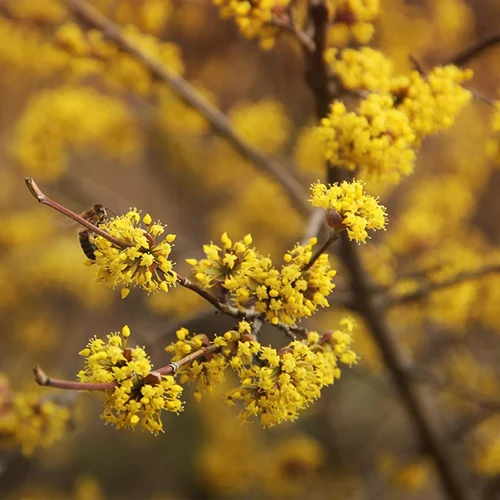Cornus mas
There’s a reason the classics stick around – they work. And there’s often something undeniably appealing about whatever’s worked for a long period of time. Exhibit A: the cornelian cherry.
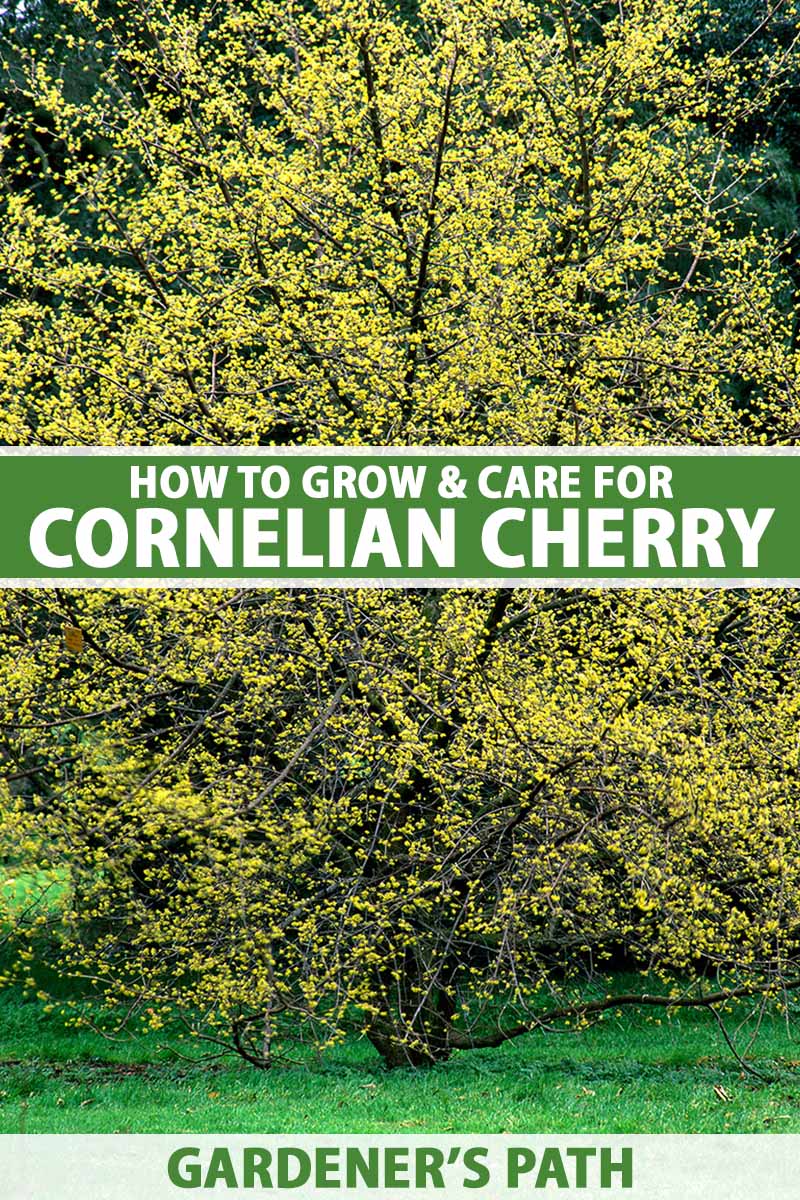
We link to vendors to help you find relevant products. If you buy from one of our links, we may earn a commission.
Cultivated for millennia, Cornus mas has the old-school aesthetic that – if you close your eyes and use your imagination – really takes you back to Ancient Greece.
As a fan of Greek mythology, I can totally picture the Argonauts of the Heroic Age gathering in a grove of cornelian cherry trees to talk strategy before embarking on their quest to retrieve the Golden Fleece.
You may not be hosting Hercules and Orpheus at your place anytime soon, but with the cornelian cherry in your garden, the vibe of Antiquity will certainly be present.
Given its beauty, toughness, and delicious fruits, the tree is well worth adding to any landscape.
Growing these isn’t super complicated, but it definitely warrants a write-up. This growing guide will teach you how to cultivate and care for these plants. Don’t worry, though – it won’t be in Greek.
Let’s get into it!
What You’ll Learn
What Are Cornelian Cherry Trees?
Hardy in USDA Zones 4 to 8, the cornelian cherry is native to central and southern regions of Europe as well as west Asia.
Typically found in dry brushlands and deciduous forests, this tree is a member of the Cornaceae family and the Cornus genus, alongside the flowering and kousa dogwoods.
The multi-stemmed plant has a mature height of 15 to 25 feet, a mature width of 12 to 18 feet, and an oval to rounded habit, depending on whether or not you prune away the lower branches.
Doing so is ideal if you wish to grow grass beneath the canopy, since low branching blocks out the sun somewhat.
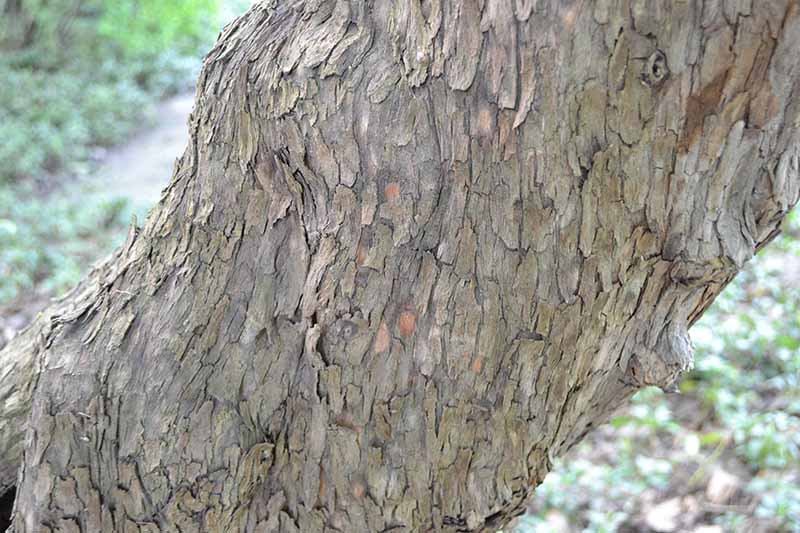
The bark is attractive, gray-brown to rich brown, and it exfoliates in flaky scales.
The simple leaves are oppositely arranged, shaped like elongated and pointed eggs, and colored a dark and glossy green. The autumn color is a purplish-red, but the leaves often drop in late fall before they have a chance to change color.
Clumps of yellow flowers borne in umbel inflorescences emerge in March, and persist for at least three weeks. As one of the earliest-flowering trees, cornelian cherry receives almost no competition from other trees during its blooming period.
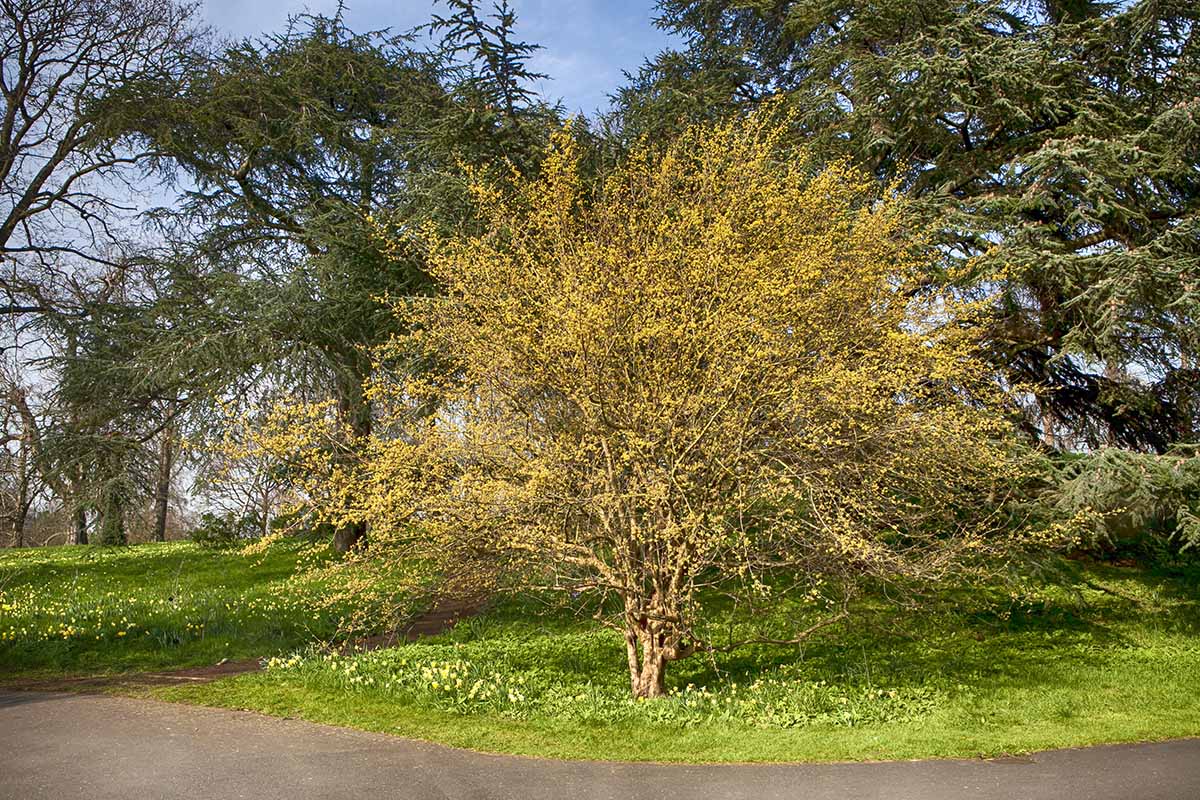
A cornelian cherry is capable of pollinating itself, but cross-pollination between different varieties tends to result in higher fruit yields.
Once pollinated, the blooms eventually give way to olive-shaped red or yellow drupes – aka cornels – which attain peak color in July.
The fruits attract birds and small mammals, and fall from the tree when fully ripe.
Used in syrups, jams, and preserves, cornels are high in vitamin C and they are also quite edible raw. At peak ripeness, they taste like a cross between sour cherries and cranberries.
If you’re in a rush for fruits, you won’t have to wait forever – fruiting usually begins within two to five years, while full yields are usually produced starting in years five to eight.
Cultivation and History
Speaking of the fruits, their use as food for humans goes way back… at least 7,000 years, in fact.
In Northern Greece, cornels were found in the remains of meals consumed by Neolithic peoples indigenous to the region.
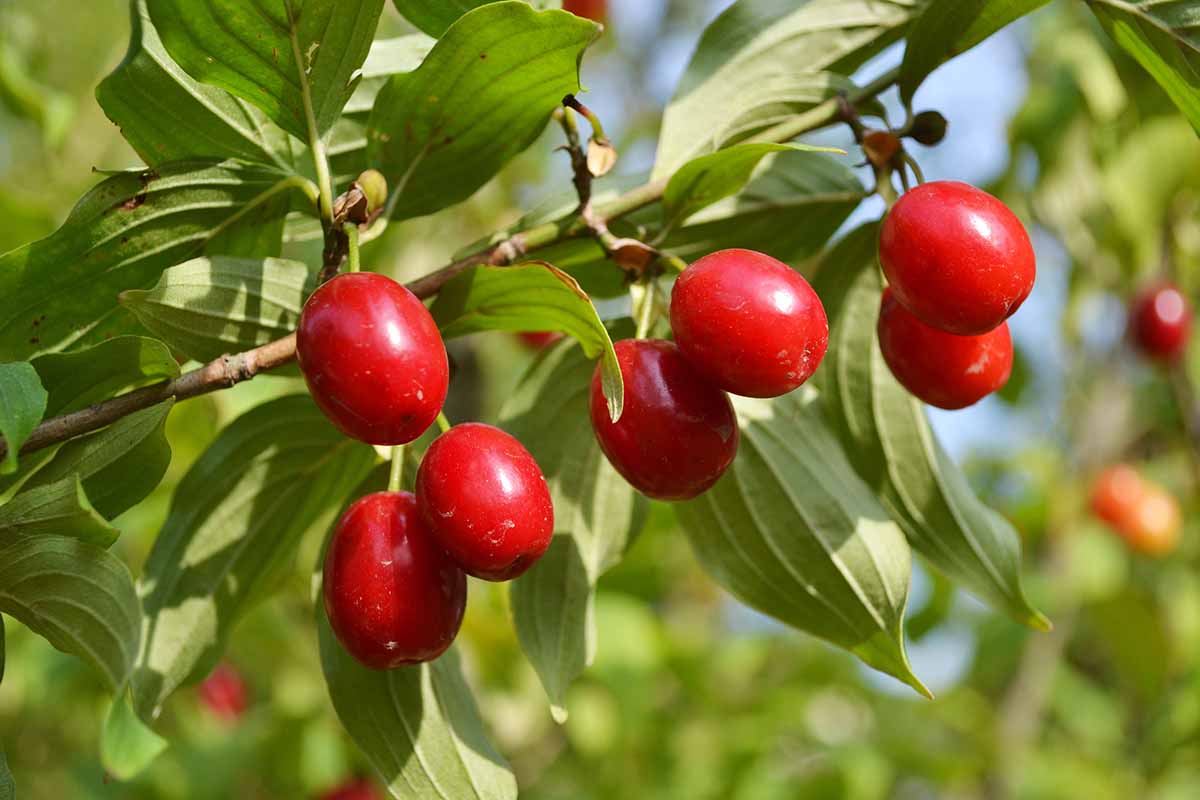
Along with its edible fruits, cornelian cherry trees were prized by the Ancient Greeks and Romans for their hard wood, which was used for crafting bows, spears, and javelins.
Red dye from the bark was used to color fezzes with their distinctive red hue. The cornels were also used medicinally, and recommended to treat dysentery and gastrointestinal issues.
The literature of Ancient Greece and Rome contains numerous references to the plant.
In Homer’s “Odyssey,” Odysseus and his men were turned into pigs after being fed fodder containing cornelian cherry fruits by the witch Circe, while the Trojan horse in the “Iliad” was constructed with cornelian cherry wood.
Additionally, the Roman poet Ovid referenced the gathering of the cornels in his poem “Metamorphoses.”
During the Middle Ages, the tree was grown in monastery gardens throughout continental Europe. Introduced to Britain in 1597, this species became a common planting in English gardens by the eighteenth century.
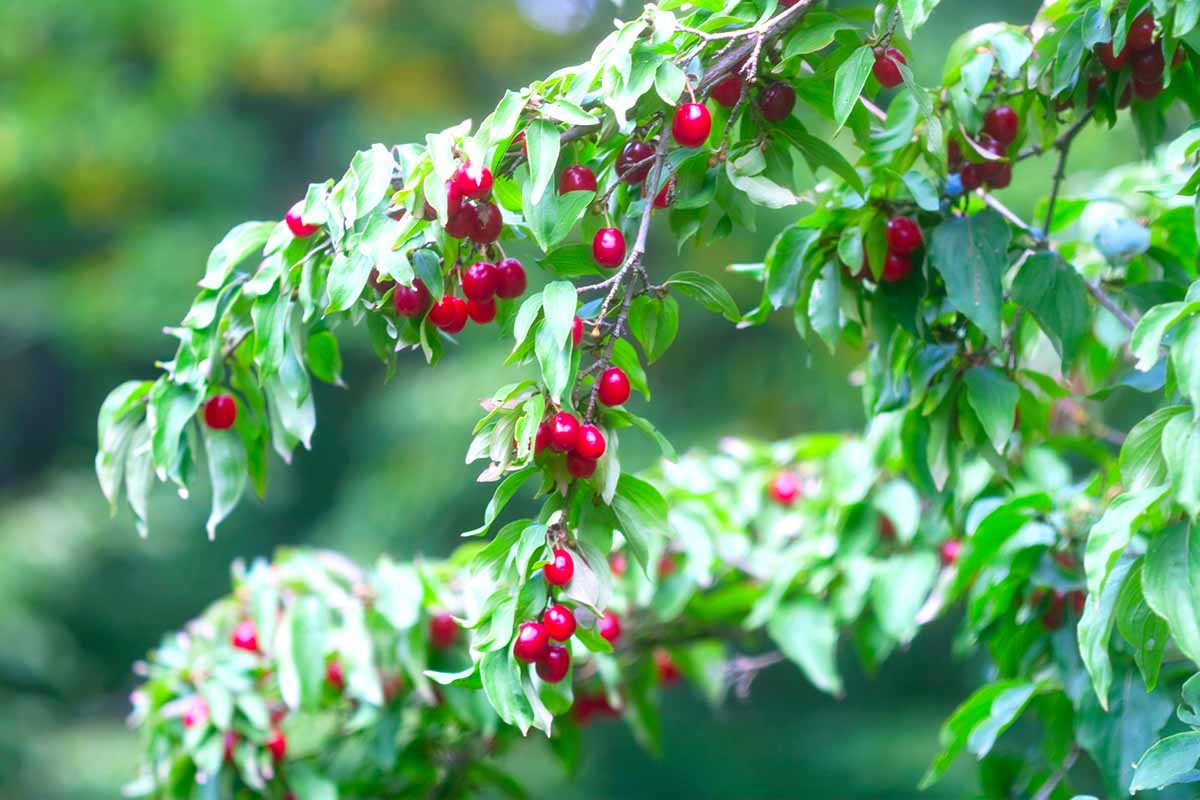
During the subsequent centuries, the cornelian cherry became more valued for its utility in the landscape than as a fruit tree, especially in the United States.
But people in many parts of Europe and west Asia still appreciate the fruits, sell them in their markets, and use them in desserts.
Propagation of Cornelian Cherries
As a type of dogwood, this tree can be propagated effectively by sowing seeds, taking stem cuttings, or transplanting.
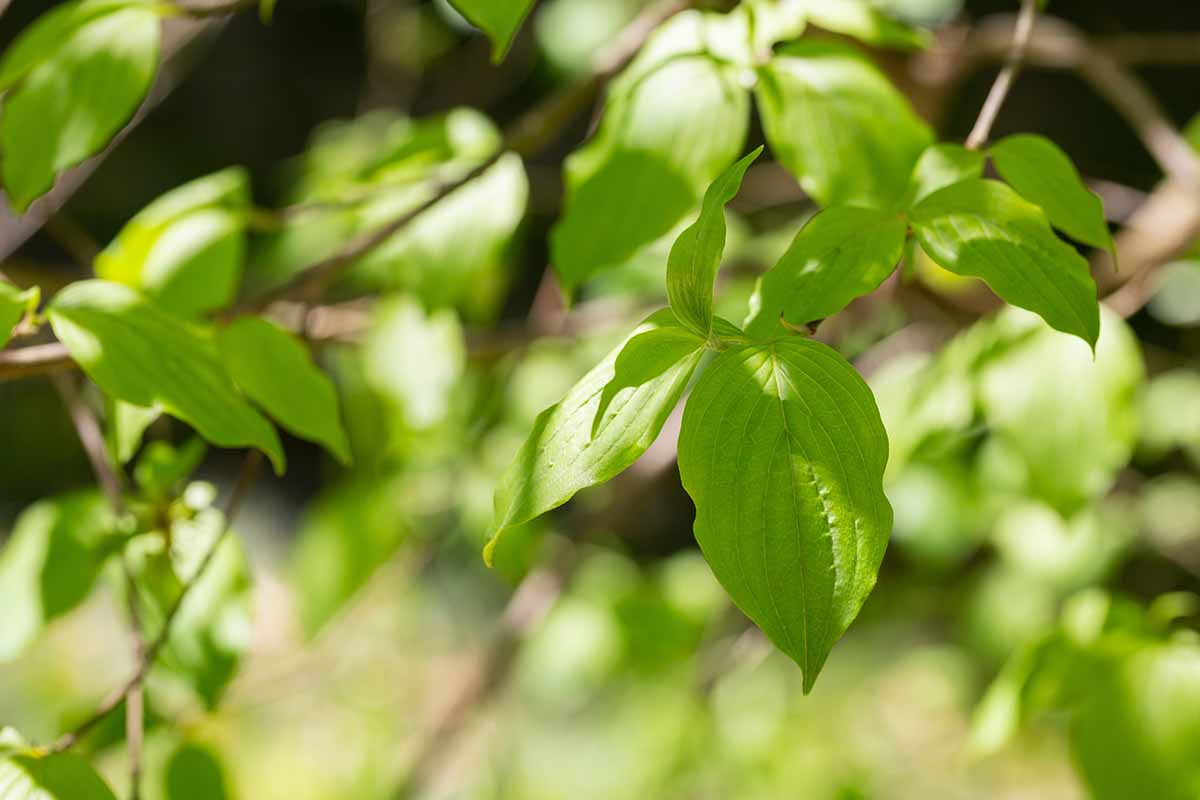
Propagating from seed is tougher than taking cuttings, which in turn is tougher than transplanting.
Some folks like the challenge of raising a plant from its infancy. If this sounds like you, then go with seed or cutting propagation.
If you just want a plant in the ground ASAP, then transplanting a sapling is probably the best method for you.
The unique specifics of propagating C. mas definitely deserve a brief hashing out.
From Seed
Promptly harvesting dropped fruits is a surefire way to acquire some sow-able seeds.
The fruits will need to be harvested upon ripening – once they reach peak color in July, you can either shake the tree or wait for the tree to drop its fruits naturally.
Once harvested, remove the seeds from the pulpy coat, wash them off, and subject them to 90 to 120 days of moist stratification at 70 to 85°F, followed by 30 to 120 days of moist stratification in the refrigerator.
Place them in a plastic baggie with a mix of peat moss and perlite.
Afterwards, they’ll need to be sown in moist, well-draining media next to a sunny indoor window, as they need light to germinate.
Once they germinate and seedlings grow large enough, you can harden them off before transplanting outdoors the following spring, as described below.
From Cuttings
You can take softwood cuttings in June or July. With a sterile blade, remove four to 10 inches of a terminal shoot, defoliate the bottom half, and treat the cut ends with an IBA rooting hormone before sticking each into its own pot that’s filled with moist, well-draining media.
Keep the cuttings in a location with warm indoor sunlight and maintain even moisture until they’re ready for hardening off and transplanting.
Hardening off simply entails bringing your seedlings and/or cuttings outdoors on an early spring day for 30 to 60 minutes, then increasing the exposure each following day over the course of a week to 10 days.
Once they’re hardened off, you can transplant into fertile, moist, and well-draining planting sites.
Make sure to space the sites 12 to 25 feet apart, depending on whether you want them together as a hedge or to stand out apart from each other.
Transplanting
If you purchase bare root transplants, soak their root systems in water for three to 24 hours prior to transplanting time.
When it’s time to transplant, prepare fertile, well-draining planting sites. Space each specimen 10 to 50 feet apart, depending on whether you want to hedge your plantings or have them stand apart as specimens.
For each transplant, dig a hole that’s about the depth of the root system, and a bit wider, so that you have room to work.
Containerized saplings can be lowered into the hole straightaway, while bare roots should have their roots spread out over a soil mound in the bottom of the hole. Gradually backfill the hole with adjacent soil and water it all in.
When it’s all said and done, the crown should be level with the soil line, and any existing root flare should be left exposed. Make sure to keep the transplant’s root zone moist as the plant becomes established.
How to Grow Cornelian Cherry Trees
Even though it’s tough, cornelian cherry isn’t above some tender loving care. And the best way to give a plant a little extra TLC is to provide it with the conditions that it prefers.
Climate and Exposure Needs
A planting site situated somewhere in USDA Hardiness Zones 4 to 8 is absolutely essential. You’ll also want to ensure that the tree receives full sun or partial shade.
Soil Needs
One of the strengths of the cornelian cherry is its ability to tolerate a variety of different soil textures and a broad pH range of 5.0 to 8.0.
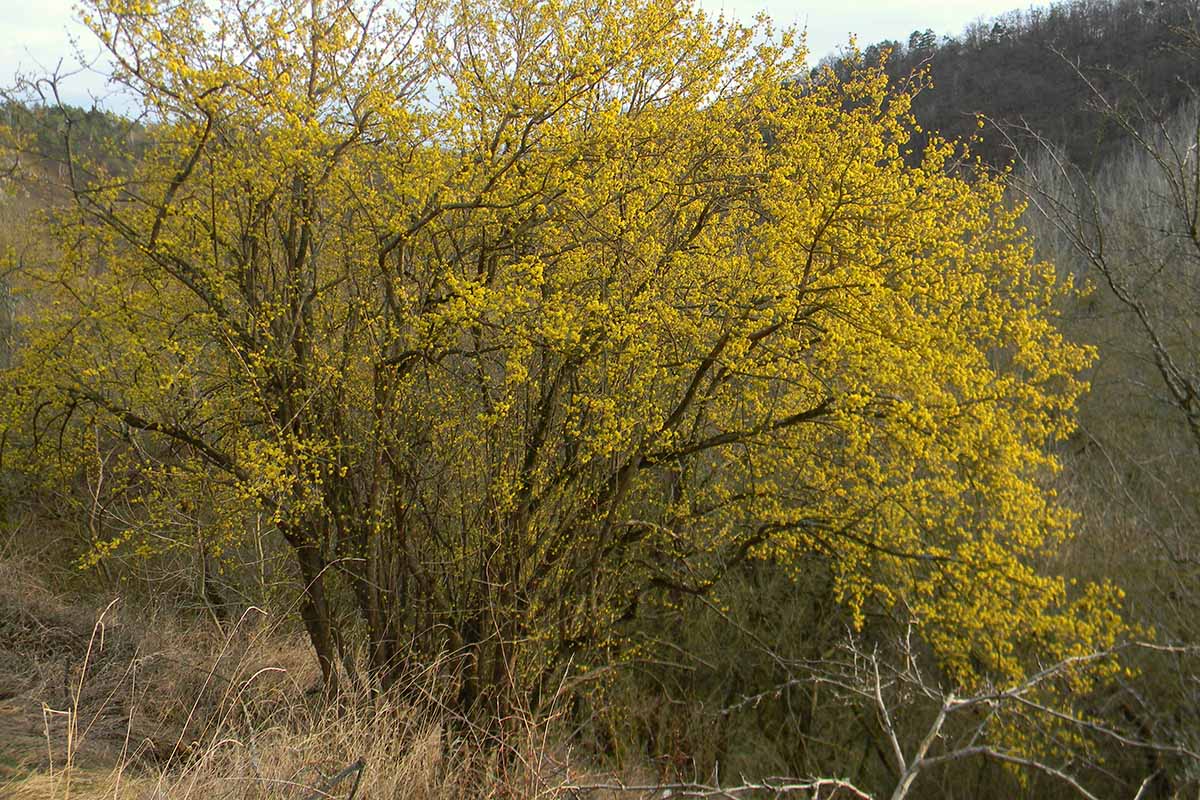
As long as the soil is fertile and well-draining, this tree will do just fine.
Water and Fertilizer Needs
C. mas should sit in moist soils, so water whenever the top two to three inches of the soil feels dry. This tree can tolerate moderate drought, so don’t fret if you occasionally irrigate late.
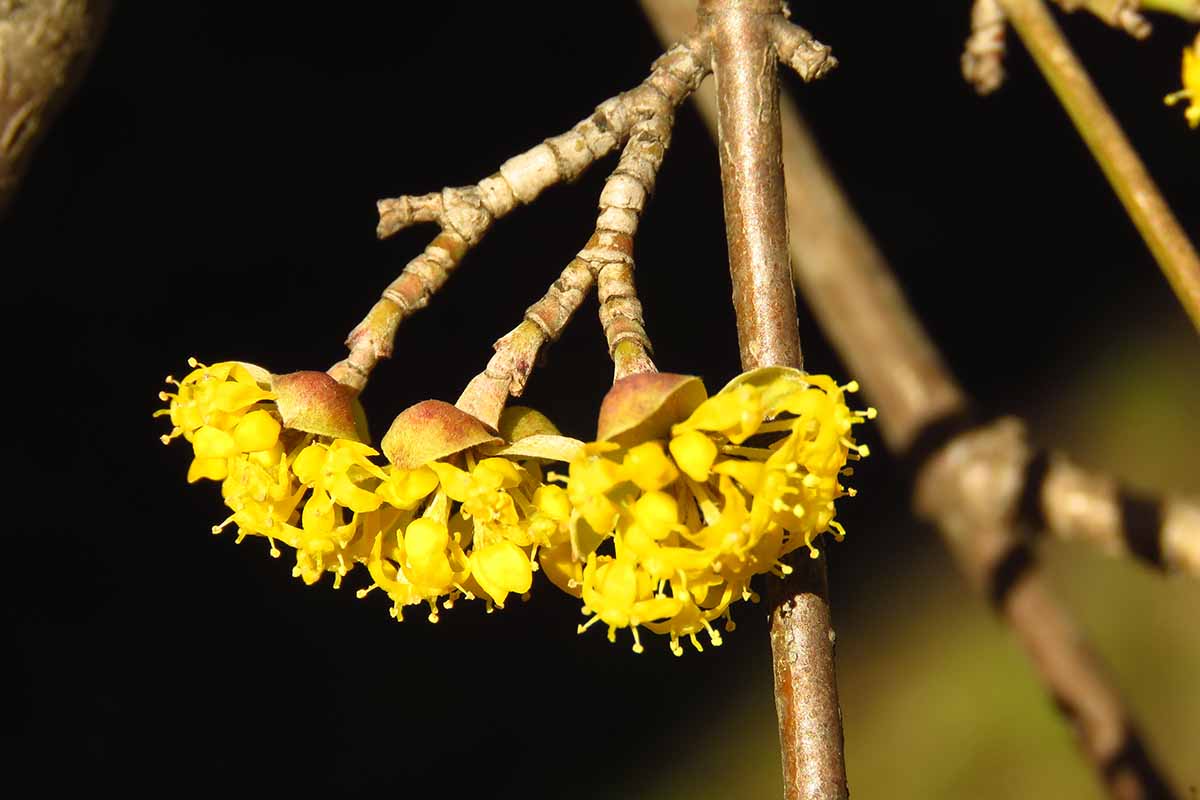
In order to maintain fertile soil, you should add a few inches of rotted manure or compost to the root zone each spring.
This should take care of its nutrient requirements, without the need for supplemental fertilizers.
Growing Tips
- Provide full sun or partial shade.
- Plant in well-draining and fertile soil with a pH of 5.0 to 8.0.
- Irrigate whenever the top two to three inches of soil feels dry to the touch.
Pruning and Maintenance
Cornelian cherry is quick to put out suckers from the base and below the lower branches, which can change its form from tree to shrub very quickly.
These suckers can be removed whenever you notice them, along with any damaged, dead, or diseased branches.
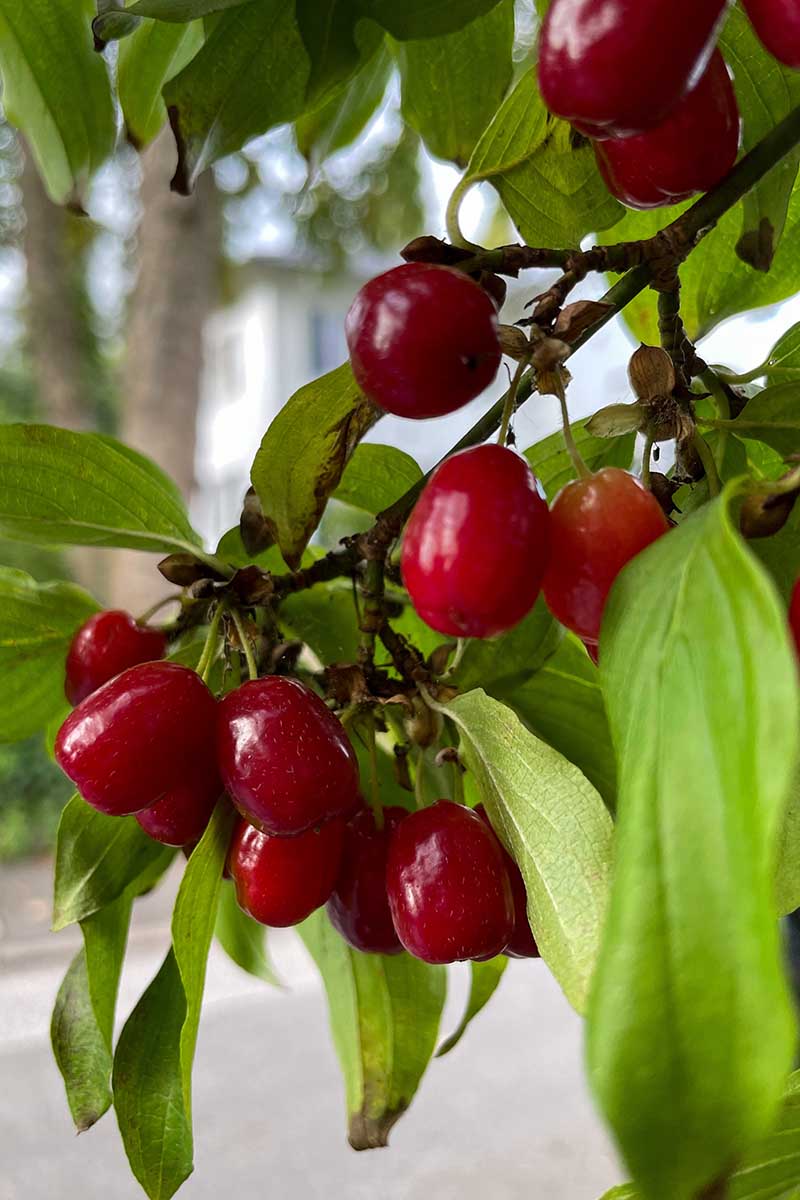
In order to allow light to reach any grass growing below the canopy, it may be necessary to prune away the lower branches.
Additionally, airflow can – and should! – be improved by removing any rubbing, crossing, or otherwise intrusive branches. This more involved pruning session should occur in spring, after flowering takes place.
As a deciduous tree, cornelian cherry will drop its leaves each year, which should be raked up if you want to keep the ground clear.
A two- to four-inch layer of mulch maintained around the trunk will aid in moisture retention and suppress the growth of unsightly weeds.
Cornelian Cherry Cultivars to Select
Need a standard cornelian cherry? Here’s a three- to four-foot transplant to start you off, available from FastGrowingTrees.com.
Save for the Star Wars sequel trilogy, unique diversions from old favorites are almost always a good time – cornelian cherry cultivars are proof.
Here are some that I find especially fascinating:
Alba
Other than its white fruits, ‘Alba’ doesn’t really differ much from the standard species. But that lone difference is enough to set it apart!
Aurea
Similarly to ‘Alba,’ ‘Aurea’ has much in common with a plain ol’ cornelian cherry, save for glossy golden foliage that turns orange come fall.
It’s tough for dark green to get old, but if it does, ‘Aurea’ has you covered.
Flava
Reaching a mature height of 20 feet, ‘Flava’ produces yellow cornels that are earlier, sweeter, and larger than those of the standard species.
A vigorous grower to boot, ‘Flava’ is quite the horticultural catch.
Nana
Want the aesthetics of the standard cornelian cherry, but in the form of a tiny shrub? ‘Nana’ is perfect.
With a height of three feet and closely-spaced nodes, this variety is excellent for tight spaces or creating small lines of hedging.
Variegata
As you could probably gather from the name, ‘Variegata’ has strikingly beautiful variegation.
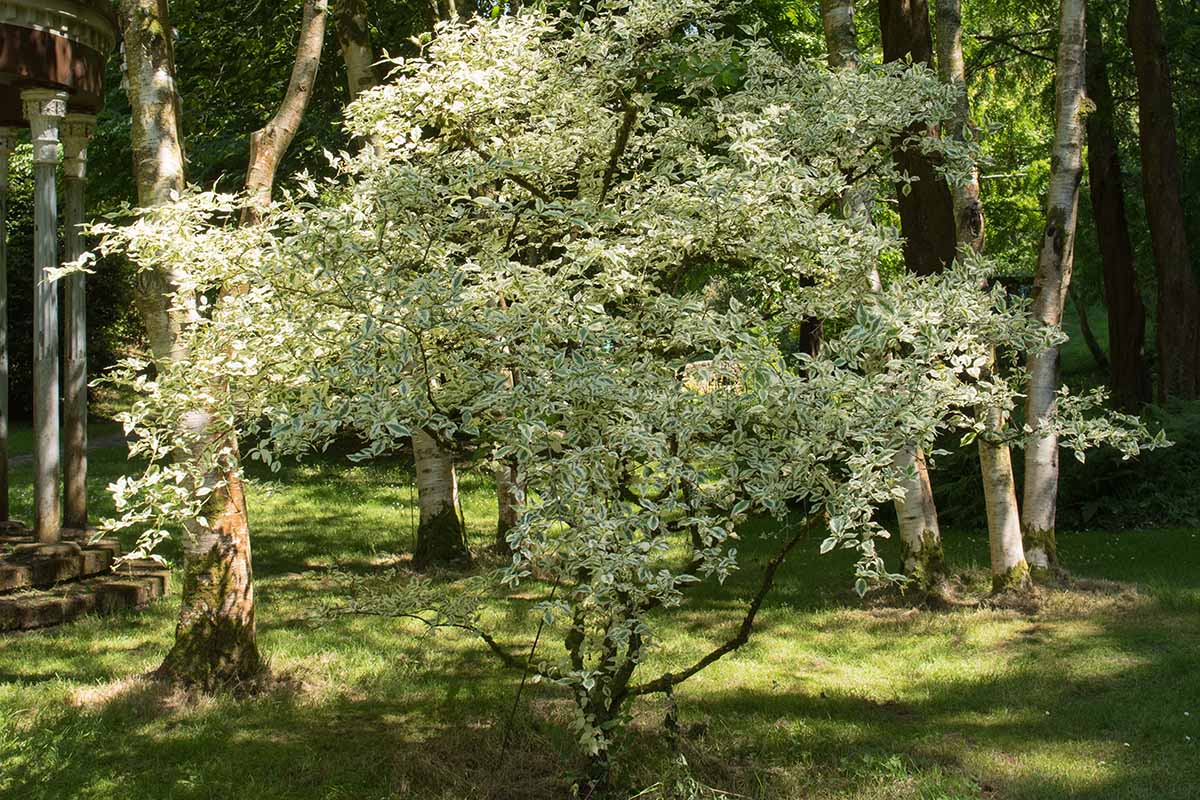
With creamy white margins on the leaves, this variety practically screams, “notice me!”
Managing Pests and Disease
Much like C. kousa, C. mas is renowned for its pest and disease resistance.
Even infamous Cornus issues such as dogwood anthracnose and dogwood borers don’t pose a threat to the cornelian cherry.
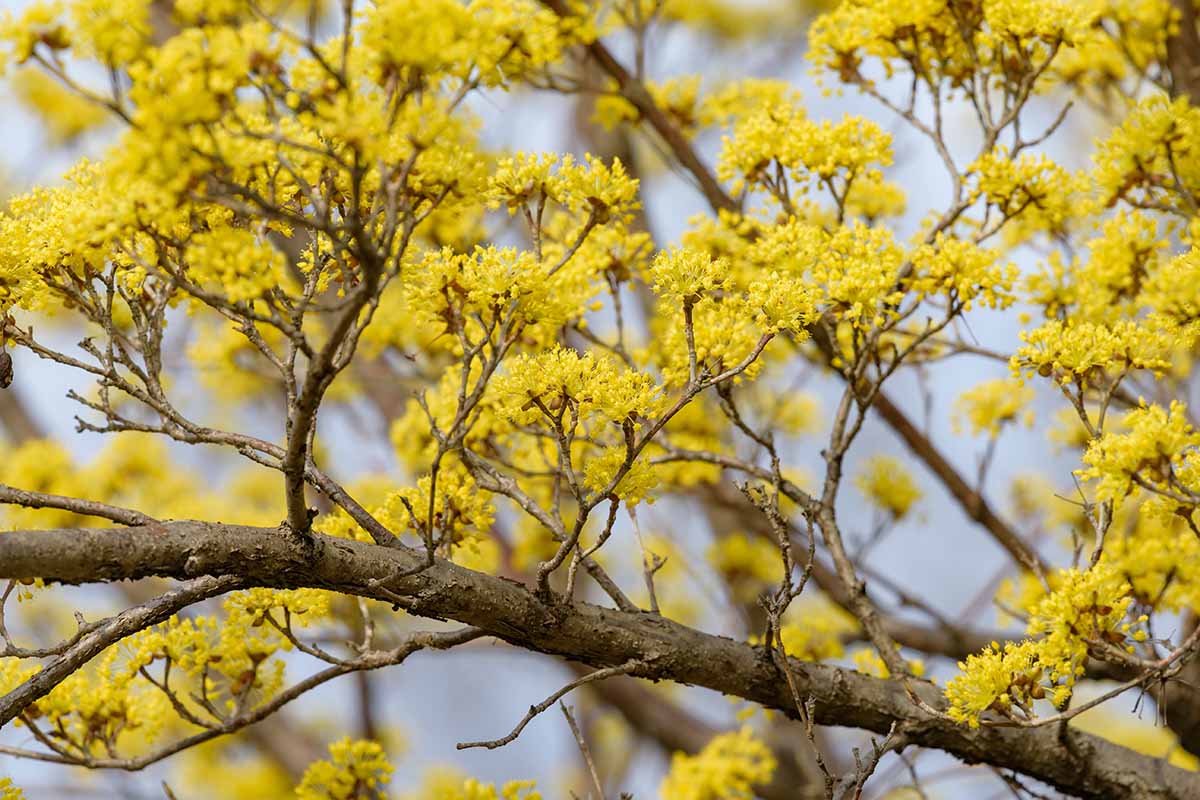
No plant is invincible, though, so using disease-free plants, clean soils, and sterilized gardening tools will help keep your garden sanitized.
Proper cultivation of your cornelian cherry will ensure that it’s kept as healthy as possible so you can start on the right foot for dealing with any health issues that do crop up.
But if you’re still worried, revisiting the typical pests and diseases of dogwood trees will help you to know what to do in the event of an infestation or infection.
Best Uses for Cornelian Cherry Tree
Hoo, boy… This ain’t a short list, let me tell ya.
For starters, a cornelian cherry looks stunning all on its lonesome – no accent or pairing required.
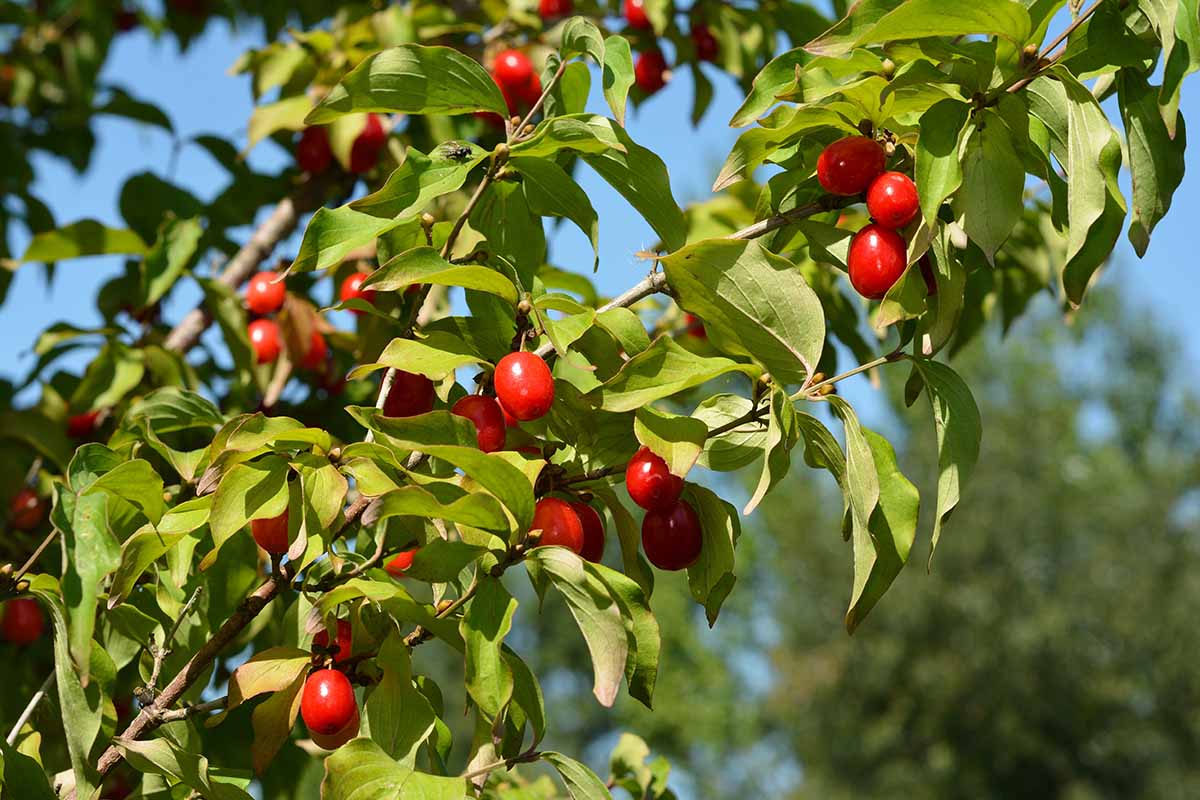
You can put this tree next to structures as a foundation planting, or with other cornelian cherries as part of a border, hedge, or screen somewhere in your landscape.
C. mas also looks right at home in woodland gardens, given its aesthetic and ability to attract classic woodland critters “Snow White”-style.
Beyond its ornamental applications, the delicious drupes of cornelian cherry can be consumed raw or used as an ingredient in more elaborate culinary concoctions.
Our writer Kristine Lofgren has experience cooking with them. She’s combined chopped cornels and olives in a tasty vinaigrette, paired the fruit with dark chocolate for a delicious tag-team of flavor, and suggests making a homemade cornel salsa to pair with pork.
One of Kristine’s regular concoctions is homemade pavlova.
For those who don’t know, a pavlova’s primary ingredient is meringue: an airy and soft, yet crisp confectionary that I find hyperpalatable to a level bordering on addictive.
Add cornelian cherry quick jam, top it with some fresh basil, and you’ve got yourself a truly incredible dessert.
Be aware that removing the pits requires patience. Some sources recommend boiling to make them easier to remove, but in Kristine’s experience, this takes quite a while – turning the fruit to mush in the process.
Quick Reference Growing Guide
| Plant Type: | Deciduous tree | Flower/Foliage Color: | Yellow/dark green |
| Native to: | Central Europe, southern Europe, western Asia | Maintenance: | Low |
| Hardiness (USDA Zones): | 4-8 | Tolerance: | Deer, dogwood anthracnose, dogwood borers, drought (moderate), urban conditions, various soils and pH levels |
| Bloom Time: | Late March to early April/spring | Soil Type: | Fertile |
| Exposure: | Full sun to partial shade | Soil pH: | 5.0-8.0 |
| Time to Maturity: | 5-8 years | Soil Drainage: | Well-draining |
| Spacing: | 10-50 feet | Attracts: | Small mammals, songbirds, miner bees |
| Planting Depth: | 1/2 inch (seed), depth of root system (transplants) | Uses: | Border, edible fruits, foundation, hedge, screen, specimen, woodland gardens |
| Height: | 15-25 feet | Order: | Cornales |
| Spread: | 12-18 feet | Family: | Cornaceae |
| Water Needs: | Moderate | Genus: | Cornus |
| Common Pests and Diseases: | Root rot | Species: | Mas |
The Cornelian Cherry: It’s Truly Legendary
Whether describing a recently dropped album or an amazingly delicious sushi roll, I’m guilty of abusing the word “legendary.”
But this time, in the case of C. mas – since it has appeared in the actual legends of Antiquity – I feel justified in my usage.
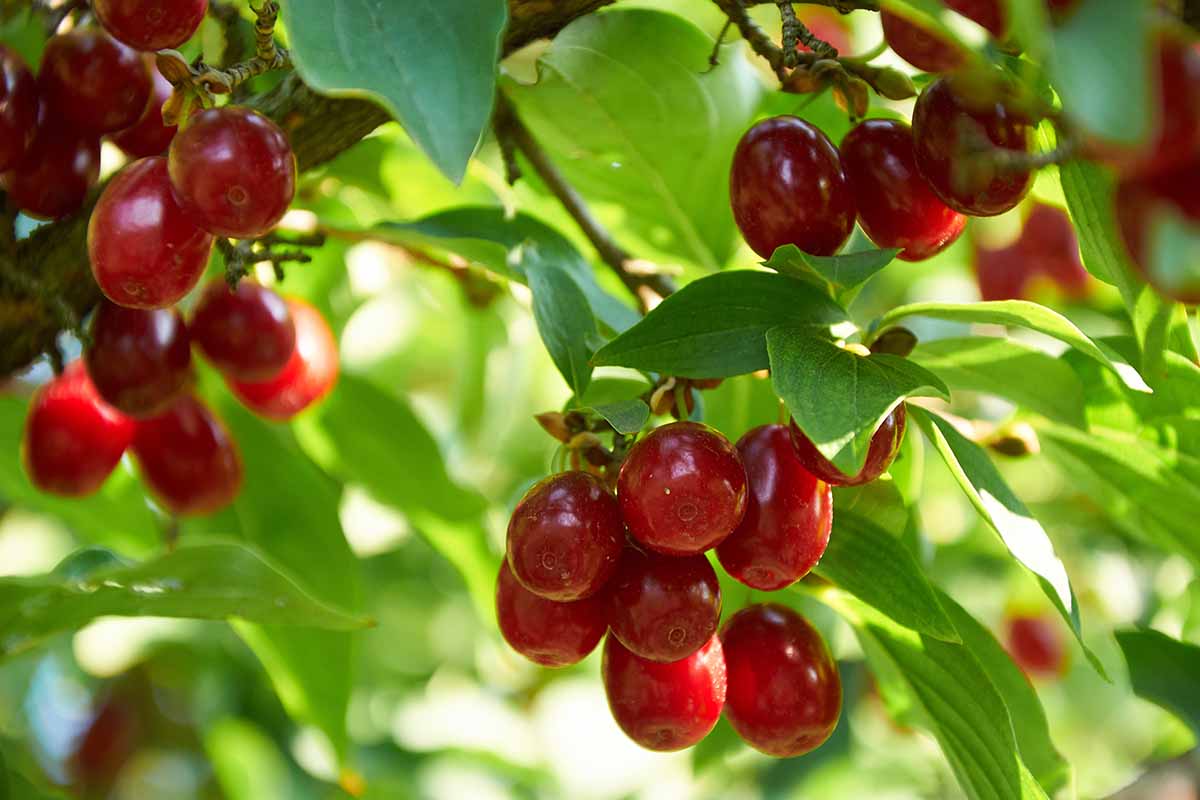
The cornelian cherry will beautifully serve you and your garden well for years to come. Many years, in fact – the plant can live for 200 years, at least in ideal conditions. That’s a lot of cornels!
Questions, comments, remarks, anecdotes, notes… all of this and more can go in the comments section below!
Up for learning more about growing dogwoods? Behold:
